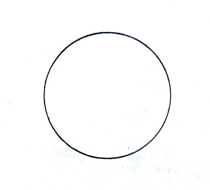SPATIAL RELATIONSHIPS
The principle of spatial relationships is extremely important in animation drawing. Spatial relationships are all about the positioning of one line to another. All drawings are made up of lines. Each line represents something. Lines usually define a shape. The distance between these lines will determine the volume of the shape.
Since characters are rarely symmetrical, the angle that you view the object from will determine it's shape.
Let's start with the simplest shape: a circle.

If you use a circle template, the distance from any part of the line to the opposite, through the center is exactly the same.
You can draw a circle freehand, but most likely, it won't be a perfect circle. You can come close sometimes. I once told my class, during an excercise in drawing circles, that with enough practice you can draw a perfect circle freehand and they challenged me to do it with a single line - one shot- start at one point and come right around to the start and make it a perfect circle. I grabbed my pencil and a piece of paper and drew an amazingly perfect circle! They pulled out a circle template and it was bang on. They were staggered and amazed that I did this right in front of them. I have to admit, I've never been able to do it just like that again. It was like one of those fancy basketball shots over the shoulder from the stands - once in a million - but try to do it again and it's almost impossible. You can come really close though with practice.
 I use the scribble technique for drawing circles. It'll get you as close to a proper circle as is possible.
I use the scribble technique for drawing circles. It'll get you as close to a proper circle as is possible.

So, why talk about a circle? It's the basic shape that all animators use when drawing characters - for the heads, bodies, hands, etc. You're going to use it alot.
So, back to our circle, Let's call it a ball. How big is this ball?
Can't answer the question can you? There's no reference to scale it from. For all you know, it could be the size of an atom or a planet. You need something near it that you can identify as having a specific size.

Even in this example, is this the finger of a 2 year old child or a 2000 foot giant? Usually the environment is what provides you with the best size reference.
If we were to now use a square we still have the same problem. Without any relationship we can't tell the scale.

In this case, I've drawn a square with equal sides. If I alter the spatial relationships of the lines I can create a rectangle.

This would be the same as pressing down on the ball.

Altering the spatial relationships of the lines changes our perception of the object.
What if I were to skew one side of the rectangle?

What does this mean?
What if I told you this shape was a wall? Tell me what you know about it now.
What is your point of view? Where is your horizon line?
What about now?

What if I add another plane?

And then change the horizon line...

If I change the spatial relationships of the lines, I change your perception of the shape.

These two cubes are no longer the same.
If it is your job to draw a character design and keep the character "on model", you must pay attention to the spatial relationship of each line to the other. If you don't, the character will not look the same, just like the two boxes above.